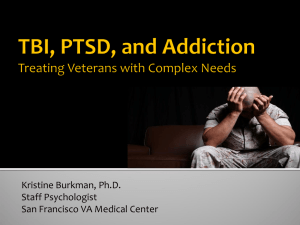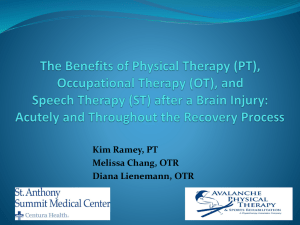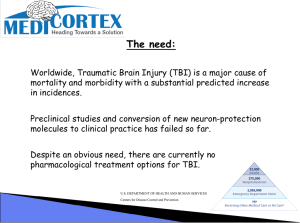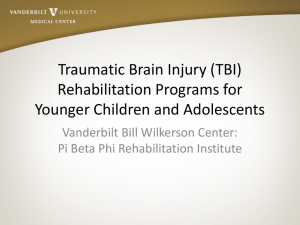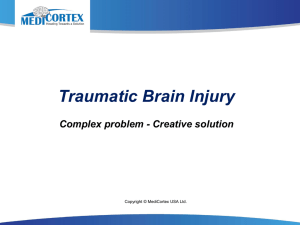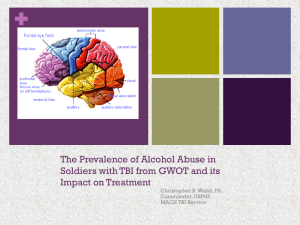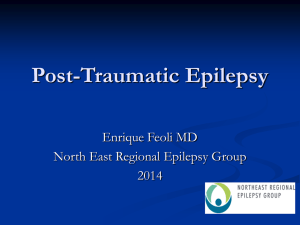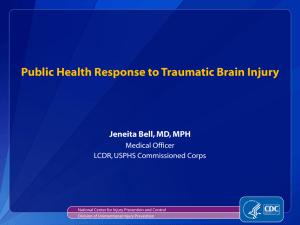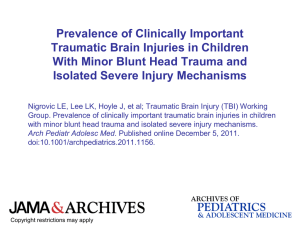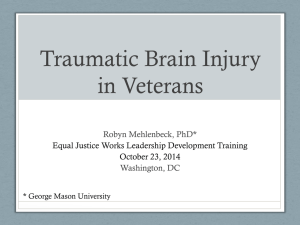Brief Intervention for Problem Substance Use
advertisement
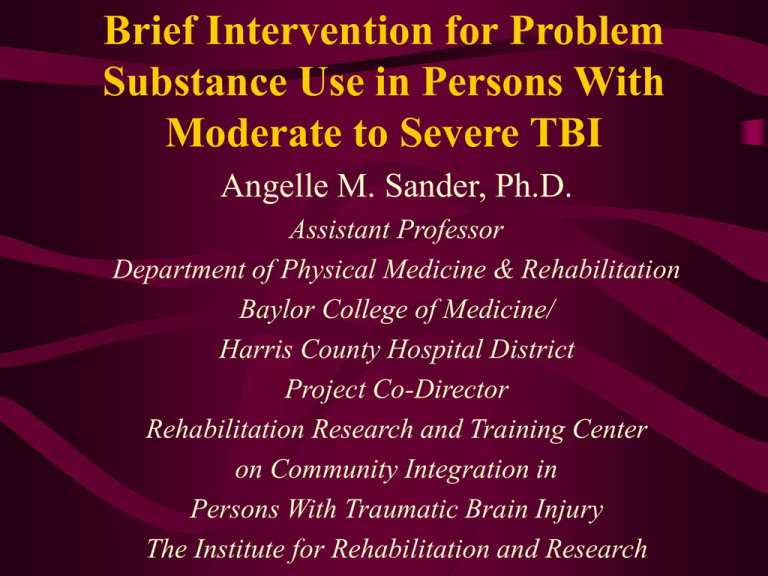
Brief Intervention for Problem Substance Use in Persons With Moderate to Severe TBI Angelle M. Sander, Ph.D. Assistant Professor Department of Physical Medicine & Rehabilitation Baylor College of Medicine/ Harris County Hospital District Project Co-Director Rehabilitation Research and Training Center on Community Integration in Persons With Traumatic Brain Injury The Institute for Rehabilitation and Research Grant Support • Rehabilitation Research and Training Center on Community Integration in Persons With Traumatic Brain Injury – Co-Project Directors: Angelle M. Sander, Ph.D. & Margaret A. Struchen, Ph.D. – Director of Training: Karen Hart, Ph.D. – Co-Investigator: Sunil Kothari, M.D. Brief Intervention for Problem Substance Use • Joint project between The Institute for Rehabilitation and Research (Texas) and Ohio State University • Principal Investigators – Angelle Sander, Ph.D. (Texas) – John Corrigan, Ph.D. & Jenny Bogner, Ph.D. (Ohio) • Level I trauma centers – Ben Taub General Hospital (Houston) – Grant Hospital (Columbus) Pre-Injury Substance Abuse • Blood alcohol levels at time of injury- 36 to 51% positive • Structured interviews or questionnaires- 37 to 66% positive for alcohol abuse • Other drug use- 36 to 37% Pre- and Post-Injury Alcohol Use Among Patients With TBI Normative Pre-injury 60 Post-injury N=87 50 40 30 20 10 0 Abstainer Infrequent/Light Moderate/Heavy Kreutzer et al., 1990 Impact of Alcohol Abuse History on Outcome After TBI • Associated with a reduced rate of good outcome on the Glasgow Outcome Scale (Ruff et al., 1990) • Associated with emotional and behavioral deterioration at 6 months post-injury (Dunlop et al., 1991) • Associated with re-injury/subsequent TBI (Kaplan & Corrigan, 1992) Impact of Alcohol Abuse History on Outcome After TBI • Associated with impaired event-related potentials indicating cognitive slowing in response to stimulation (Baguley et al., 1997) • Associated with poor neuropsychological test performance (Brooks et al., 1989; Dikmen et al., 1993) Impact of Alcohol Abuse History on Outcome After TBI • Predictive of employment (Sherer et al., 1999; MaMillan et al., 2002) • Predictive of independent living status (MacMillan et al., 2002) • Predictive of life satisfaction (Corrigan et al., 2001) Barriers to Substance Abuse Treatment After TBI • Cognitive deficits, including impaired memory, judgment, and awareness • Social environment • Boredom, inactivity • Lack of experienced referral sources • Not ready to change Transtheoretical Stages of Change Model (Prochaska et al., 1992) • Persons with problem behaviors operate at different stages of readiness for change. • Intervention works best if it is matched with the person’s readiness for change. Stages of Readiness for Change • Precontemplation: problems not acknowledged and no change considered • Contemplation: acknowledges problem, but no commitment to change • Preparation: sets goals for change; may begin preliminary attempts to change Stages of Readiness for Change • Action: makes changes in behavior and in the environment to support changes • Maintenance: changes established and goal is to prevent relapse Readiness to Change Alcohol Use After TBI • Occurrence of trauma may result in a “teachable moment” (general trauma and spinal cord injury) • The majority of persons with TBI in an inpatient rehab program were in contemplation or action stage (Bombardier et al., 1997). • Those with higher BALS or higher preinjury alcohol consumption showed greater readiness to change. Randomized Trial of a Brief Substance Abuse Intervention • Persons with complicated mild, moderate, and severe TBI admitted to trauma services at one of the 2 participating Level I trauma centers • Persons who screen positive for history of alcohol and/or drug abuse are randomly assigned to receive brief intervention or hospital standard of care. Exclusion Criteria • Age <18 • Glasgow Coma Scale score >12 upon ER admission AND no positive CT/MRI findings • If no GCS available, then loss of consciousness < 20 minutes • Discharged to an inpatient rehab facility other than those associated with the 2 Level I trauma centers • Discharged to a nursing home or long-term care facility or to a prison Screening Criteria for Randomization to Treatment • Admit blood alcohol level > or = .08 • Laboratory tests positive for cannabis, cocaine, or any other illicit substance • Positive response to at least 2 CAGE questions • Score of >5 on the Drug Abuse Screening Test • Alcohol Use Questionnaire: >14 drinks per week for men; >7 for women; one day per week of 5 or more drinks; any illicit drug use Brief Intervention • Videotape created by Ohio Valley Center for Brain Injury Prevention and Rehabilitation (Ohio State University): education regarding the impact of alcohol on functioning after TBI (10 minutes) • Brief (10-15 minute) motivational interview: encourage discussion of recovery goals and how substance use will help or hinder goals; nondirective • Delivered when fully oriented, up to one month post-discharge Follow-Up Measures (3-4 months) • Alcohol Expectancy Questionnaire-III – 40 Likert items – 8 factors • Positive expectancies: Global Positive, Social and Physical Pleasure, Social Expressiveness, Sexual Enhancement, Power and Aggression, Tension Reduction • Negative Expectancies: Cognitive and Physical Impairment, Careless Unconcern – Global Positive and Cognitive and Physical Impairment used for current study Follow-Up Measures • Readiness to Change Questionnaire – 12 Likert items assessing a person’s belief about drinking or drug use and the perceived importance of change – “Sometimes I think I should cut down on my drinking.” – Precontemplation, Contemplation, and Action scales – Currently using 10 items based on Bombardier & Heinemann’s validation study for TBI Follow-Up Measures • Alcohol and drug use questions from the TBI Model Systems national dataset – Adapted from questions used in the CDC’s National Household Survey on Drug Abuse – “During the past month, how many days per week or month did you drink any alcoholic beverages on the average?” – “On the days when you drank, about how many drinks did you drink on the average?” Follow-Up Measures • Alcohol and drug use questions from the TBI Model Systems national dataset – “…how many times during the past month did you have five or more drinks on one occasion?” – “During the past month, have you used illicit or non-prescription drugs?” Status of Study • Data collection began August 2004 • 106 persons enrolled and screened for problem history – 73 Texas – 33 Ohio • 70 met criteria for problem substance use history and randomized to treatment or standard of care – 48 Texas – 22 Ohio Demographics By Center Gender Male Race White Black Hispanic Education <12 years Unemployed Texas Ohio 72% 76% 19% 32% 43% 79% 12% 3% 47% 28% 12% 45% Injury Severity by Center Texas Ohio ER admit GCS score 11.55 (SD=3.81) 11.15 (SD=4.91) Length of Stay 16.88 (SD=25.19) 9.33 (SD=8.72) Proportion of Persons Meeting Problem Substance Use Criteria 90 80 70 60 50 40 30 20 10 0 BAL TOX LAB CAGE DAST Alcohol Illicit Use Drug Use Follow-Up AEQ-III Scores By Group Intervention Control 25 20 15 10 5 0 Global Positive Cognitive & Physical Impairment Readiness to Change Scores by Group Intervention Control 14 12 10 8 6 4 2 0 Precontemplation Contemplation Action Follow-Up Alcohol Use By Group Intervention Control 4 3.5 3 2.5 2 1.5 1 0.5 0 Days drank How many drinks Five or more Acknowledgements • Allison Clark, M.A. and Dan Graves, Ph.D. for data analyses • Allison Clark, M.A., Marie Silva, M.S.W. for project coordination • Jason Ferguson- consumer advisor

